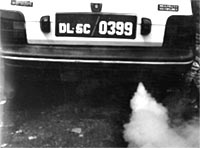A cleaner start
 AFTER a car has been started, conventional catalytic converters take a few minutes to get hot enough to tackle exhaust emissions. The emissions during these first few minutes account for about 80 per cent of all pollution from cars fitted with converters. To overcome this problem, a Connecticut-based company, Precision Combustion, has now developed a device that achieves 'lightoff' - the point at which half or more of the hydrocarbon emissions can be cleaned in under 15 seconds (New Scientist, Vol 153, No 2063).
AFTER a car has been started, conventional catalytic converters take a few minutes to get hot enough to tackle exhaust emissions. The emissions during these first few minutes account for about 80 per cent of all pollution from cars fitted with converters. To overcome this problem, a Connecticut-based company, Precision Combustion, has now developed a device that achieves 'lightoff' - the point at which half or more of the hydrocarbon emissions can be cleaned in under 15 seconds (New Scientist, Vol 153, No 2063).
The device, called microlith, is fitted between the engine and a standard catalytic converter. It consists of a series of squat metallic discs or monoliths, made from a coated metal alloy riddled with small pores or channels. The length of these channels is only five times the diameter. But in ceramic or metallic filters used in standard converters the length is 75-150 times the diameter.
When gas flows over a surface, a boundary layer of still gas builds up. The longer the flow path, the thicker the boundary layer. In catalytic converters, the pollutant molecules must diffuse through this layer to get to the catalytic surface of the monolith, which breaks them down. A thick boundary layer makes this more difficult. As the channels through the microlith's disc-shaped monoliths are short, the boundary layer is kept thin. This has the added benefit of allowing beat from the exhaust gas to spread into the catalyst more quickly, so that it reaches its operating temperature sooner. The short slow path results in heat and mass transfer coefficients that are greater than those of typical monoliths.
The company has found that the performance of the microlith 'preconverter' does not deteriorate with age and operation. "After 50,000 miles of engine ageing, this combination converter is still able to lightoff in less than 15 seconds," says Subir Roychoudhury, leader of the team that developed the device.
Related Content
- CNG to hydrogen-CNG: why switch, and how
- Graded Response Action Plan to control air pollution in Delhi-NCR in ‘Very poor’ and ‘Severe’ categories comes into effect from October 17, 2017- says EPCA
- Some simple, inexpensive steps will get you cleaner air
- Ambala Unites For Record-Breaking Waste Segregation Project
- World Coal Production Just Had Its Biggest Drop on Record
- Children in the chulha trap: Eliminating toxic exposure in anganwadis of Bihar
